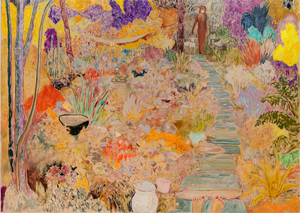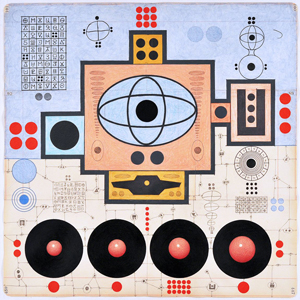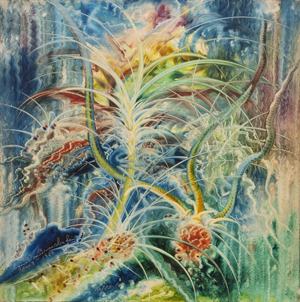Who Are You Calling Naive?
John Haberin New York City
Hayley Barker and Karla Knight
Eugene Von Bruenchenhein and Melvin Way
Just who are you calling naive? The presenter was speaking up for folk and outsider art at Sotheby's—an institution that no one would call naive. And then there are contemporary artists who know their way around Modernism and outsider art alike.
Hayley Barker knows enough to borrow from an entire litany of early modern art, while bringing it into her life in the twenty-first century. Karla Knight knows about conspiracy theories, but she is onto them as well, although I am not so sure about Eugene Von Bruenchenhein. Drawings show his determination to trace every last botanical, human, or inhuman structure—and to defy them all with a denser structure all his own.  Still, they only hint at the force of an atomic bomb in his work in color, on display with the mad science of Melvin "Milky" Way. Call their work a world apart, but do not call it naive.
Still, they only hint at the force of an atomic bomb in his work in color, on display with the mad science of Melvin "Milky" Way. Call their work a world apart, but do not call it naive.
Countryside and country music
Edward M. Gómez was serving in 2018 on a hallmark of art-world insiders at that, a panel. Others in the discussion included a lawyer, the director of the Outsider Art Fair, and two dealers who specialize in outsider art. Just in case I missed the point, the latest show at one has a take on Blue Nude by Henri Matisse. Hayley Barker has the chops to deliver a close copy and the freedom to make it her own. How else to recover the raw edge of Modernism's apostle of pleasure? How else, too, to recover the Symbolism of Odilon Redon or the anxiety and anger of Edvard Munch apart from the women she knows well?
Stepping off East Broadway is like entering a richer world, but a chastened world as well. Barker calls her show "The Grass Is Blue," but it is just as often a fiery red. Streaked red and yellow skies peek out from the vegetation, without breaking its density. They reveal her debt to modern artists who set color free—from Félix Vallotton to Pierre Bonnard and Matisse. Her stains and daubs, though, stand apart from Vallotton's well-defined brushwork and Matisse's unbroken fields of color. They are all-enveloping, but never claustrophobic or liberating.
These gardens are laden with feeling, but the feelings may be hard to pin down. If blue means sad, do not discount the richness. And if red means fire, in a title like Red Fire Morning, sailors know when to take warning. Then, too, the show's title quotes Dolly Parton, whose sings of her longings even as she insists on her independence, meaning from men. Barker herself paints mostly women, and their feelings are strong but uncertain, too. A single red rose, the sole exception to women and landscapes, could stand for withering and isolation or an offering of love.
Barker is hardly a folk artist, unlike Jake McCord coming next to the gallery, but she does see art as therapy, and past self-taught artists have descended into madness. Her essays in Vintage Self Help look at art in context of trauma, healing, and shamanism. Personally, I have my doubts about all three, and the degree of healing in her art is uncertain, too. A self-portrait, not in the show, has her at work as an artist, but unable to proceed. The portrait of another is intimate and flattering, but the woman is Still Angry. A woman in a forest wears her long dress like a dancer and the foliage as a halo, but she is still Mourning.
Gómez knows art from both sides, inside and out, as a graphic designer and critic, with books on Adolf Wölfli and Yoko Ono. If Wölfli could earn attention both as outsider artist and with Art Brut, Ono has made a career of playing naive. She is, after all, out to bring universal peace, love, and understanding. Art these days is even more distrustful of boundaries—between art and design, abstraction and representation, high art and low. And that leaves open what to do with outsider art. Should one view it alongside the mainstream, as a benchmark and competitor, or to grant it its due place apart?
Barker brings the two sides into the same work. She indulges in languor and the old equation of woman and landscape, but she can still move comfortably from the countryside to country music. A peacock wanders aimlessly in a kind of Eden, but the two figures in the distance have already fallen. Or so I judge from their clothes, but the man wears the white robe of a prophet. A garden path leads to the silhouette of a man masked for the pandemic. It is a darkening and unsteady path, but it does end in necessary precautions and a welcome.
Believe it or not
Karla Knight does not believe in UFOs, but you may by the time she is done with you. Her "Notes from the Lightship" compel belief thanks to their bright colors, plain shapes, and cryptic alphabets. They ask you to linger long enough to decipher them all, even after you know that you never will. They may well be about looking and lingering to judge by their schematic eyes, or they may be looking back at you.  Some recurring symbols turn the nested ovals into atoms, while others might be planets in a dark interstellar space or merely abstract. And then there are the spaceships, believe it or not.
Some recurring symbols turn the nested ovals into atoms, while others might be planets in a dark interstellar space or merely abstract. And then there are the spaceships, believe it or not.
Knight must know better than to mock belief. Her father wrote entire books about UFOs and the paranormal, and why start another family fight? She got the idea of invented alphabets from her son, and who would discourage a child from creating and exploring? Still, she also knows better than to obsess over such things. She is not out to fill every last square inch. Her work could pass for outsider art, at a gallery that specializes in just that, but the cartoon stylings have a winning simplicity.
She has halfway respectable influences as well. They number Buckminster Fuller, who can strain credibility himself, and Native American calendars, but also artists. The gallery mentions enough to invite disbelief at that—including Francis Picabia, Adolph Gottlieb, and Alfred Jensen. Knight falls somewhere between Gottlieb's "pictograms," with their Abstract Expressionist insistence on leaving their mark, and Jensen's denser patterns akin to Lego sets. Her materials also bridge painting and drawing. She works in paint and pencil on paper, later mounted on canvas.
If Knight builds on outsider art, the back room has the real thing. Eugene Von Bruenchenhein considered himself more than just a baker in Milwaukee, as he was by day—or even just an artist. He was, he wrote, "Freelance artist Poet and Sculptor Inovator Arrow Maker and Plant Man Bone artifacts constructor Photographer and Architect Philosopher." (He seems to have been a self-taught grammarian and speller as well.) He meant it, too, enough to make sculpture out of chicken bones. In drawings from his mid-fifties, his ambitions only grew.
As Renaissance men go, he belonged to the America of his time—enough to have found his bones in TV dinners. Still, these ink drawings from the 1960s hardly lack sophistication. Their density and symmetry suggest not an obsessive compulsive, but a craftsman. They also move easily between biomorphic and pure abstraction. Some approach spider webs or intricate machines. Others could pass for fine botanical drawings from more than a century ago.
Ink gathers into thicker highlights or curves while fanning out to either side, as if of its own accord. It can seem to fold over itself, like crossword puzzles in linear perspective—or plant life. Folk art has served science before, with Eugen Gabritschevsky, and Modernism, with Art Brut. Von Bruenchenhein cannot claim the same exuberance or precision. The drawings lack Knight's fascination with the unknowable or sense of humor. They might compel belief all the same.
Atoms and molecules
One thinks of an outsider artist, almost by definition, as in a world of his own. He (so often male) might be confined in an institution or, like Joseph E. Yoakum, in his own head. Von Bruenchenhein, though, was at his most fantastic when he kept up with his time. He painted Atomic Age at age sixty, in an age of bomb shelters and school kids in drills hiding under their desks— what W. H. Auden, the poet, called an "age of anxiety." He keeps up with the American dream, too. His atomic blast is either rising from or leveling a shining city on a hill.
what W. H. Auden, the poet, called an "age of anxiety." He keeps up with the American dream, too. His atomic blast is either rising from or leveling a shining city on a hill.
Von Bruenchenhein may understand the dreams and the anxiety, but he takes pleasure in the explosion. I have never seen a mushroom cloud so spiky and colorful. He may well associate the blast with his peculiar confidence in his genius. (In his mind, the gallery explains, his nickname, Gene, morphed easily into genii.) It guided him to plausible renditions of plants and sea creatures, such as an octopus and jellyfish. Yet their tendrils, like his observations, run wild.
They sure kept him busy. He inscribed every painting with not just a year, but a day and a number—also serving, almost always, in lieu of a title. Atomic Age, from December 4, 1960, is No. 887, and he had nearly twenty-five more years to go. Six months after a look at his drawings, a show sticks to just a few years of what it calls his "Phantasmagorical Paintings." The phantasmagoria only begins with the tendrils, pushing to the edge of a panel. It lies even more in the color, filling his species, blasts and skies with an electric mix of blue, yellow, red, and green.
Defiant as ever, Von Bruenchenhein paints another likely stand-in as an African warrior confronting the viewer. Do not be shocked if the warrior's spear and headdress morph into botany as well. Oil on Masonite thrusts his colors forward and deepens the electricity. If either the stereotype or the appropriation on his behalf are racist, like the "primitivism" of early modern art, and they are, he is mocking racism as a sign of his times, too. It is a dark vision, but still colorful. As seriously as he took himself, ridiculously so, it might even be funny.
The gallery compares his "fireworks" to others of his time, like Max Ernst, Leonora Carrington, and Roberto Matta—the clumsiest of Abstract Expressionists and a bridge from Surrealism. It cannot rescue him for sanity, but it does leave him in the realm of art. In the back room, Melvin "Milky" Way comes off as more of a mad scientist, with an equal emphasis on the madness and science. His twenty years in the guise of HAI, or Hospital Audiences Inc., have left Way with dozens of drawings, on irregular black and white fragments. He might have ripped them on the spur of the moment from larger sheets, to capture every thought before it is gone. And those thoughts take the form of chemical formulas.
They are perfectly reasonable formulas at that, until you try to decipher them—or to separate them from the added text. Way, now in his mid-sixties, went to technical school, but I have no idea whether he took organic chemistry or biochemistry. He might just have known enough to keep a textbook in front of him as he worked, because he sought the essence of life. He had his molecules where Von Bruenchenhein would rather split the atom. A double bond links his inspiration to Erato, the muse of music, and to Artemisia Gentileschi, the Baroque painter with an unmatched emotional intensity and command of violence. Science, art, music, feminism, and revenge are still an intriguing formula.

Hayley Barker ran at Shrine through December 5, 2020, Karla Knight and Eugene Von Bruenchenhein at Andrew Edlin through July 11. Von Bruenchenhein returned with Melvin Way through January 23, 2021.




